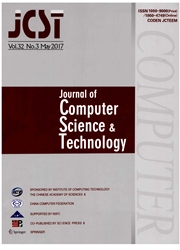

 中文摘要:
中文摘要:
在无线传感器网络和放的技术的进展启用监视动人的对象的新应用程序。一些这些应用例如交通管理,要求可能性查询目标的未来轨道。在这篇论文,我们建议初始数据访问法, ANR 树,哪个支持预兆的询问。在对象在抑制网络以内移动的地方,我们集中于真实生活环境,例如道路上的车辆。我们基于单元自动机的图介绍一个基于模拟的预测模型,它充分利用网络限制和随机的交通行为。我们的技术与线性预测模型强烈不同,它有低预言精确性并且当适用于真实交通,速度经常变化时,要求经常的更改。数据结构与组织搬到类似的移动模式的邻居目标的适应单位扩大 R 树。适应单位的预言的运动没被一条单个轨道给,但是相反在交通条件上基于不同假设由二条轨道跳并且从模拟获得了。我们的实验,继续二不同数据集, ANR 树是的表演实质上比 TPR 树更有效的一个数量级,并且是更可伸缩的。电子增补材料电子增补材料为在 http://dx.doi.org/10.1007/s11390-007-9031-9 的这篇文章是可得到的并且为授权的用户可存取。
 英文摘要:
英文摘要:
Advances in wireless sensor networks and positioning technologies enable new applications monitoring moving objects. Some of these applications, such as traffic management, require the possibility to query the future trajectories of the objects. In this paper, we propose an original data access method, the ANR-tree, which supports predictive queries. We focus on real life environments, where the objects move within constrained networks, such as vehicles on roads. We introduce a simulation-based prediction model based on graphs of cellular automata, which makes full use of the network constraints and the stochastic traffic behavior. Our technique differs strongly from the linear prediction model, which has low prediction accuracy and requires frequent updates when applied to real traffic with velocity changing frequently. The data structure extends the R-tree with adaptive units which group neighbor objects moving in the similar moving patterns. The predicted movement of the adaptive unit is not given by a single trajectory, but instead by two trajectory bounds based on different assumptions on the traffic conditions and obtained from the simulation. Our experiments, carried on two different datasets, show that the ANR-tree is essentially one order of magnitude more efficient than the TPR-tree, and is much more scalable.
 同期刊论文项目
同期刊论文项目
 同项目期刊论文
同项目期刊论文
 期刊信息
期刊信息
